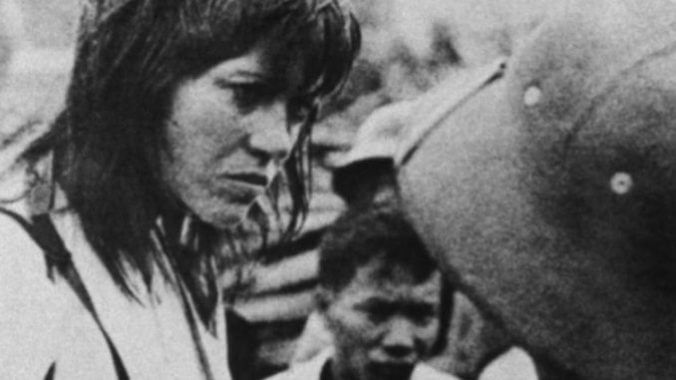Jean Luc-Godard’s First Death: Letter to Jane and Tout Va Bien 50 Years Later

On June 7, 1971, Jean-Luc Godard was riding on the back of a motorcycle that lost control and slid under a bus. After barely over a decade working as an already legendary director, the 40-year-old was lying on the pavement with a fractured skull and broken pelvis. His injuries would leave him in a week-long, life-or-death coma (and ultimately cost him a testicle). Godard was kept alive with insurance from the largest production he had worked on since his abandonment of so-called “commercial cinema,” if his ‘60s works can be called that in the first place. Now that his life was in jeopardy so was the production, and therefore again his life. Godard’s wife, Anne Wiazemsky, was able to arrange for doctors to keep his condition a secret, leaving his collaborator—the other half of his mind during his radical era—Jean-Pierre Gorin, to maintain a ruse that the film was still going to be made.
Tout va bien was not a return to commercial cinema, but it was a return to the larger stage of the international festival world. After 1967’s Weekend, Godard told his usual bunch of collaborators that they would need to look for work elsewhere, as he was leaving the industry that they’d so revolutionized. Not the medium, but the industry, and soon he would try to apply his increasingly radical left-wing politics to his modes of filmmaking. After the failed revolution, the political flash-in-the-pan, or whatever you want to call the events of May ‘68 in France, Godard and Gorin started work on a collaborative film project that would reject any bourgeois notions of filmmaking like story or character, and instead serve as tools of revolutionary provocation.
They started calling themselves the Dziga Vertov Group, after the futurist agitprop-maker from the Soviet Montage school they thought best represented a filmmaker whose personality dissolved away in favor of revolutionary representation. They survived off of college and lecture tours, where the duo would screen their films as openings to dialogues between themselves and the audiences. The works weren’t meant to just be seen on their own, but as beginnings to conversations. After four features as the collective (which would also ignite the collapse of another failed marriage for Godard, as Wiazemsky was also an essential collaborator), they were ready to apply their format to a larger stage, and to get the attention of big festivals and wider audiences, they needed stars for their film about the role of artists in the coming revolution.
Yves Montand, a sort of progressive-liberal French Sinatra, and Jane Fonda, that Old Hollywood star’s daughter who had wholeheartedly embraced the left-wing, feminist counterculture of the time, were chosen by Godard and Gorin both for their political affiliations and their immediate recognition as stars, their off-screen personas being reflected back on screen. They were much easier to get on board initially than to keep on call when Godard was in the hospital. Fonda, who was hesitant to take on a project with two male directors when, at the time, she was advocating for more collaboration between women, looked like she was going to drop out of the project. Gorin, infuriated, trying to keep both his project and collaborator on life support, drove to her house in the south of France and told her, “At least have the guts to tell him face to face.”
Even when the film was shooting and Godard was out of the hospital, he still needed intensive physical recovery, and although he was his ever-playful self, he didn’t have the energy to maintain a usual level of work. As recounted by Richard Brody in his biography Everything is Cinema, Godard’s contributions were “largely of a theoretical nature,” while Gorin worked to mimic the filmmaker’s famous visual stylings. Gorin was perhaps too good at this, as contemporary critics—who weren’t aware of the production woes—questioned what Gorin’s purpose was on a film that seemed to bear only the signatures of Godard.
It is an easy critique to make: Gorin, who debuted as a filmmaker with Tout va bien, was a co-author with Godard, one of the most visually recognizable filmmakers of his generation. But to only latch onto the immediately recognizable is to ignore the content of the texts, in which Gorin’s Marxist analysis is essential (it should also be noted that Gorin’s left-wing journalism was instrumental in Godard’s political development earlier in the ‘60s). Godard commented in an interview in 1972 that “the only aim of the self is to be two,” and as the Dziga Vertov Group sought to dissolve personality, both of the filmmakers—their ideas, aesthetics, inclinations—became fused. In fact, if anything truly revolutionary did happen in their time together, it was the triumph of collaboration—something the broader French left completely failed at. Their next and final project together would add clarity to this, and offer a culmination of the dialogue the two had been working through the last five years.
-

-

-

-

-

-

-

-

-

-

-

-

-

-

-

-

-

-

-

-

-

-

-

-

-

-

-

-

-

-

-

-

-

-

-

-

-

-

-

-








































